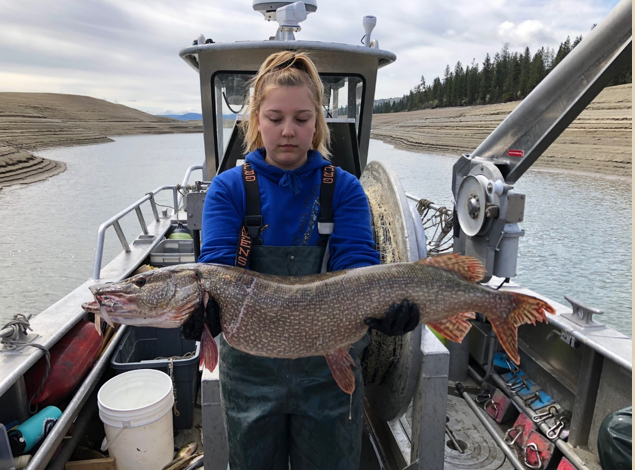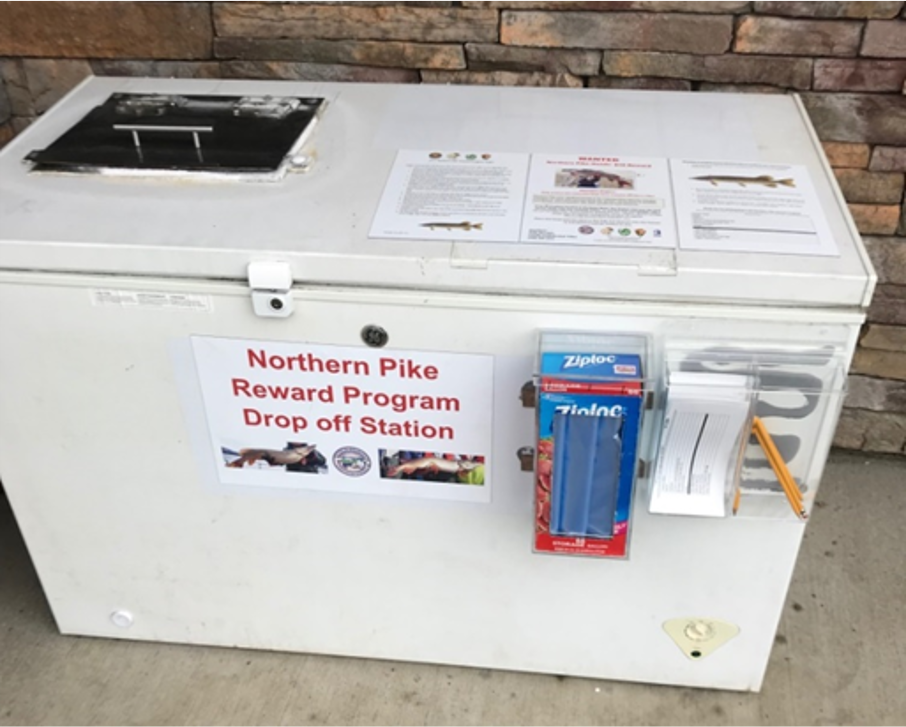Upper Columbia Tribes Gather Experts To Strategize About Accelerating The Attack On Northern Pike
- February 19, 2021
- John Harrison

The problem of invasive Northern Pike in the Columbia River Basin is one of those problems that is someone else’s until it becomes yours.
That, in essence, defines the problem, the challenge, and the solution to a fisheries issue that threatens native species like trout and bull trout in northeastern Washington and northern Idaho, and inevitably will threaten salmon and steelhead in the Columbia downriver from Chief Joseph Dam, which blocks upstream passage of those ocean-going fish.
How to improve the response to that ‘other person’s problem’ was the focus of a half-day webinar February 17 that attracted more than 100 people to share concerns, successes, advice, and ideas for solutions. The Upper Columbia United Tribes, which issued a resolution in June 2020 calling on “all appropriate agencies to fully fund prevention, control, and eradication efforts” to manage Northern Pike, coordinated the webinar.
The UCUT tribes are working with the Idaho and Washington fish and wildlife departments, university researchers, and others to eradicate, or at least control, Northern Pike. They are on the front lines of a battle against a prolific invader that literally can eat nearly everything in its path, including fish practically its own size. As they mature, Northern Pike can grow big – really big. Some weighing 30 pounds and more have been caught.
There have been successes. Tens of thousands of Northern Pike have been removed from the Pend Oreille and Columbia rivers, and from northern Idaho lakes, since 2004, when they were first detected in the Pend Oreille River and 2007 in Lake Roosevelt, which is the Columbia River impounded by Grand Coulee Dam. Most of the removals have used gillnets, but electrofishing – shocking – shallow reedy pools along the river banks to kill fish, and reward fisheries for sport anglers – the Colville Tribes offer $10 a head – also have been effective, if at times controversial.

For example, there hadn’t been much of a fishery in the Pend Oreille river in the Box Canyon reservoir between Box Canyon and Albeni Falls dams until pike proliferated, after being introduced illegally. Then the fishery boomed. Northern Pike are fun to catch.
So it was challenging for the Kalispel Tribe to confront an angry fishing public with the news that Northern Pike were a problem. But through educational outreach, the public became part of the solution by fishing for as many Northern Pike as they could catch, and the public mood changed. The Kalispel Tribe even held a fishing derby called Pikeapalooza. Adding to the mood change, public education made clear that removing Northern Pike helped protect native fish species in the river, said Joe Maroney, director of fishery and water resources for the Tribe.
In fact, that’s one aspect of the solution to the pike problem that everyone agreed on – public education is critical. The fishing public is not part of the problem, but part of the solution. So increased public education and awareness is important.
So is funding.
“Funding now for Northern Pike is for specific items, so without additional funding it would be difficult to reprogram it to other purposes,” said BJ Kieffer, director of the Spokane Tribe’s Natural Resources Department.
That’s another aspect of the solution that all agreed on – the need for guaranteed funding for the ongoing and future eradication effort.
And finally, all agreed on the need for a unified, coordinated action plan that could be implemented across state lines and across jurisdictions. But developing such a plan will be tricky for the same reason that a unified, coordinated response is difficult – multiple jurisdictions with multiple statutory responsibilities and rights. Such a multijurisdictional plan would have to be coordinated with existing state and tribal fisheries plans. But that acknowledgement led to another point of general agreement: work on a coordinated plan needs to begin right away.
Perhaps the most sobering conclusion from the panelists and participants in the webinar was the inevitability of Northern Pike impacts on other species – not only native fish species above Grand Coulee and Chief Joseph dams where native species already have been affected, but salmon and steelhead downriver.
The first five dams downriver from Chief Joseph are owned and operated by three county public utility districts, which have no-net-impact agreements with the federal government to protect salmon and steelhead as part of their operating licenses for the dams. The three PUDs – Grant, Chelan, and Douglas – are helping pay for the current Northern Pike suppression efforts in Lake Roosevelt. The thought of Northern Pike invading waters where the PUDs are spending literally millions of dollars to protect and rebuild salmon and steelhead runs is, at least, troubling.
“This is the core issue – it doesn’t become our problem until it shows up in our back yard,” said Tom Dresser, manager of fish, wildlife, and water quality for Grant PUD. “So how does this group push hard to get the political folks to take notice? It probably won’t happen until Northern Pike show up in the anadromous zone. They are going to be there – it’s not a question of if, but when.”
Justin Bush, executive coordinator of the Washington Invasive Species Council, agreed.
“The sand in the hour glass is running out; it’s just a matter of time before Northern Pike are detected below Chief Joseph. With a comprehensive plan, when that happens the incident would be considered an emergency and would have an appropriate response.”
Without a plan, he said, “the occurrence would be poorly communicated, leading to a long-term and likely underfunded suppression program. We have one opportunity, now, to light the fuse and protect the anadromous area.”
Laura Robinson, policy analyst for the UCUT Tribes, said the Tribes have received support from the Affiliated Tribes of Northwest Indians, and other agencies and organizations. She said the UCUT hope that momentum from the workshop will accelerate collaboration among the many interested – and affected – parties to work on solutions to the pike problem.
“We hope that given the political momentum on this issue and the regional interest, which is evident in the number of participants in today’s forum, that we as a forum can work together to make broader impacts to save natural and cultural resources from these voracious predators” she said.



